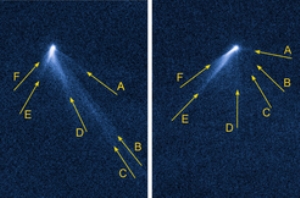Nov 13 2013
Some bodies have a very disturbing effect on the order in the solar system - P/2013 P5 is one of them. With several clearly visible tails, it may look like a comet, but orbits around the Sun within the asteroid belt - and thus cannot be unequivocally classified into either of these two categories. An international team which includes scientists from the Max Planck Institute for Solar System Research has now used the Hubble space telescope to investigate this mysterious body. Their diagnosis: P/2013 P5 is an asteroid that rotates so rapidly under the radiation pressure of the Sun that it loses material into space.
 An eccentric: Images taken by the Hubble space telescope on 10 September (left) and 23 September 2013 show P/2013 P5 with six tails, which surround it like the spokes of a cartwheel. While most of the tails became less bright between the observations, tail F significantly increased in brightness. © NASA / HST
An eccentric: Images taken by the Hubble space telescope on 10 September (left) and 23 September 2013 show P/2013 P5 with six tails, which surround it like the spokes of a cartwheel. While most of the tails became less bright between the observations, tail F significantly increased in brightness. © NASA / HST
Asteroids are robust celestial bodies. As they lost their volatile components, such as water, billion of years ago under the influence of the Sun, these rocky lumps change their appearance hardly at all. Although impacts of smaller bodies can add a further crater to the surface here and there, there is no fundamental metamorphosis. Comets, in contrast, are “gas and dust ejectors”. Material vaporises from their surface under the influence of the Sun, sweeping along dust particles as it does so.
In 1996, this view of things began to falter: on pictures of the asteroid 1979 OW7, which had later to be renamed comet 133P/Elst-Pizarro, a clear tail could be seen. A comet in the asteroid belt? Or an asteroid which ejects gas and dust? Even now it is difficult to assign these astronomical hermaphrodites, of which a mere ten or so have been identified so far, with any precision. This confusion also becomes clear in the language used: researchers talk of active asteroids or main-belt comets. The new study, headed by David Jewitt from the University of California, was intended to clarify which designation is more fitting for P/2013 P5.
“Many indications support the argument that the so-called active asteroids do not form a uniform group,” says Jessica Agarwal from the Max Planck Institute for Solar System Research in Katlenburg-Lindau. It is thought that ice sublimes (i.e. converts directly from the solid to the gaseous state) from the surface of some of them. This ice probably originates from deep inside these bodies and was possibly exposed through hefty impacts. With other active asteroids, collisions have generated plumes of dust which could be seen for months as tails. “For most of these bodies, the origin of the tail is completely unclear, however,” says Agarwal.
P/2013 P5 was initially a mystery as well. In the photos taken in August of this year, when it was discovered, it had already adorned itself with a tail. The more detailed look which the researchers now directed towards this eccentric being with the Hubble space telescope brought further tails to light: a total of six tails surround the body like the spokes of a cartwheel; the researchers have labelled them A to F.
“The number alone is evidence against the fact that the tails originate from collisions or impacts,” says Agarwal. Six impacts within a short period of time would be rather improbable. Sublimation of ice can also be as good as excluded. Since P/2013 P5 moves at the inner edge of the asteroid belt - i.e. very close to the Sun for an asteroid - it should no longer contain any ice.
The researchers therefore guessed that the body rotates so fast that it loses mass. This motion is driven by the pressure of the sunlight. Since it hits the rugged surface at different angles, all in all it can produce a total angular momentum which accelerates its rotation more and more. At some stage, this will cause the centrifugal force at the equator to become stronger than the weak gravitational force of the body, which has a diameter of only 240 metres and is thus quite small; matter is therefore ejected from the surface.
Crucial information was provided by comparing Hubble images which were taken at two different times in September this year. “There were 13 days between the observations. During this time, our research object changed a great deal,” says Agarwal. While one tail remained almost unchanged, a second one significantly increased in length and brightness. All the others became dimmer.
In computer simulations, the team of scientists succeeded in reconstructing precisely these changes. They computed the trajectories of many hypothetical dust particles of different size and different age and compared their positions with those of the observed tails. The only assumption was that the motion of the particles is affected only by radiation pressure and the gravitation of the Sun.
“Our computations and the actual observations are in very good agreement,” was the conclusion drawn by Jessica Agarwal, who carried out the computations. “It is particularly encouraging that we were able to achieve good reproduction of the temporal development between the two days of observation.”
Each of the six tails apparently originated from a different point in time, the most recent one only a few days before the Hubble photos. It was thus able to increase in brightness in the days that followed, while all the others - depending on the size of their dust particles – gradually disappeared.